The Impact of Different Types of El Niño Events on the Ozone Valley of the Tibetan Plateau Based on the WACCM4 Mode
Abstract
:1. Introduction
2. Materials and Methods
2.1. Sea Surface Temperature, Ozone and Meteorological Data
2.2. Classification of EN Events
2.2.1. Classification of EP- and CP-Type EN Events
2.2.2. Classification of SP- and SU-Type EN Events
2.3. TCO* Calculation for the Ozone Valley
2.4. Introduction to the WACCM4 Mode
3. Statistics of Different Types of EN Events and Analysis of Their Corresponding Characteristics of the Ozone Valley over the TP
3.1. Classification of EN Events
3.2. Characteristics of the Ozone Valley over the TP Affected by Different Types of EN Events
3.3. Analysis of the Flow Field near the Ozone Valley over the TP Influenced by EN
4. Causes of Influence of Different Types of EN on the Ozone Valley Based on WACCM4
5. Summary and Discussion
5.1. Summary
- (1)
- During 1979−2022, there were a total of 10 EN events. From the perspective of event establishment time, there are seven SP-type EN events and three SU-type EN events. According to the spatial pattern of SST anomaly distribution, there were five events of the EP type and CP type, respectively. Overall, the EP (SP)-type events were more intense and lasted longer than the CP (SU)-type events.
- (2)
- In the summer of the following year after the peak of EN, the ozone valley in the UTLS layer over the TP has a significant change, showing an overall zonal distribution. The calculated differences in TCO show that, on the whole, after EN events, the TCO near the low latitude (0–30° N) presents negative anomalies and becomes stronger nearer to the equator. The TCO variation north of 30° N is mainly a positive anomaly with the high-value area at approximately 40° N, which weakens the ozone valley phenomenon.
- (3)
- The effects of different types of EN events on ozone in the TP region are distinct in nature and intensity. The EP-type EN is closer to the overall distribution, whereas the distribution of the TCO anomalies of CP-type EN is different from the whole picture. In the range of 10–50° N, the TCO anomaly value is positive, but the overall TCO anomaly value is small. The negative TCO anomaly caused by SP-type EN in low latitudes is weak. The overall effect of SU-type EN is the strongest, with the TCO positive anomaly centered near the Caspian Sea and strong negative effects in the belt from southwest Russia to Eastern Europe.
- (4)
- The positive (negative) TCO anomaly in the UTLS layer over the TP in the summer of the following year of EN corresponds to the positive (negative) vorticity anomaly at 200 hPa. In the summer of the following year, at low latitudes, the updraft corresponding to the vorticity anomaly lifts the low-concentration atmosphere of the lower layer to the UTLS layer, resulting in a decrease in the TCO. At the same time, EN causes SST to rise in the Indian Ocean, which enhances the SAH through the two-stage thermal adaptation and then decreases the ozone concentration in the southern low-latitude region of the SAH through the SAH–ozone interaction.
- (5)
- The simulation results of WACCM4 are overall consistent with the observed results, and the vertical profile results further explain the differences between different EN events. Compared with the CP (SU)-type EN events, the middle and upper atmospheric upward movement in the 20° N region near the TP in summer is stronger in EP (SP)-type EN events, and the corresponding SAH is also stronger. Both of these result in a wider range of negative TCO anomalies in the southern low latitude areas.
5.2. Discussion
Author Contributions
Funding
Institutional Review Board Statement
Informed Consent Statement
Data Availability Statement
Acknowledgments
Conflicts of Interest
References
- Fang, X.; Pyle, J.A.; Chipperfield, M.P.; Daniel, J.S.; Park, S.; Prinn, R.G. Challenges for the recovery of the ozone layer. Nat. Geosci. 2019, 12, 592–596. [Google Scholar] [CrossRef]
- Chen, Z.; Liu, J.; Cheng, X.; Yang, M.; Shu, L. Stratospheric influences on surface ozone increase during the COVID-19 lockdown over northern China. NPJ Clim. Atmos. Sci. 2023, 6, 76. [Google Scholar] [CrossRef]
- Diffey, B.L. Sources and measurement of ultraviolet radiation. Methods 2022, 28, 4–13. [Google Scholar] [CrossRef] [PubMed]
- Antón, M.; Cazorla, A.; Mateos, D.; Costa, M.J.; Olmo, F.J.; Alados-Arboledas, L. Sensitivity of UV erythemal radiation to total ozone changes under different sky conditions: Results for Granada, Spain. Photochem. Photobiol. 2016, 92, 215–219. [Google Scholar] [CrossRef]
- Zhao, X.; Fioletov, V.; Redondas, A.; Gröbner, J.; Egli, L.; Zeilinger, F.; López, S.J.; Arroyo, A.B.; Kerr, J.; Maillard, B.E.; et al. The site-specific primary calibration conditions for the Brewer spectrophotometer. Atmos. Meas. Tech. 2023, 16, 2273–2295. [Google Scholar] [CrossRef]
- Tian, W.; Huang, J.; Zhang, J.; Xie, F.; Wang, W.; Peng, Y. Role of Stratospheric Processes in Climate Change: Advances and Challenges. Adv. Atmos. Sci. 2023, 40, 1379–1400. [Google Scholar] [CrossRef]
- Chipperfield, M.; Bekki, S.; Dhomse, S.; Harris, N.; Hassler, B.; Hossaini, R.; Steinbrecht, W.; Thieblemont, R.; Weber, M. Detecting recovery of the stratospheric ozone layer. Nature 2017, 549, 211–218. [Google Scholar] [CrossRef]
- Chipperfield, M.P.; Dhomse, S.S.; Feng, W.; McKenzie, R.L.; Velders, G.J.M.; Pyle, J.A. Quantifying the ozone and ultraviolet benefits already achieved by the Montreal Protocol. Nat. Commun. 2015, 6, 7233. [Google Scholar] [CrossRef]
- Polvani, L.M.; Previdi, M.; England, M.R.; Chiodo, G.; Smith, K.L. Substantial twentieth-century Arctic warming caused by ozone-depleting substances. Nat. Clim. Chang. 2020, 10, 130–133. [Google Scholar] [CrossRef]
- Son, S.W. Stratospheric ozone loss by very short-lived substances. Nat. Clim. Chang. 2023, 13, 509–510. [Google Scholar] [CrossRef]
- Cai, X.; Wang, W.; Lin, D.; Eastes, R.W.; Qian, L.; Zhu, Q.; Correira, J.; McClintock, W.E.; Gan, Q.; Aryal, S.; et al. Investigation of the Southern Hemisphere mid-high latitude thermospheric ∑O/N2 responses to the Space-X storm. J. Geophys. Res. Space Phys. 2023, 128, e2022JA031002. [Google Scholar] [CrossRef]
- Wang, W.; Hong, J.; Shangguan, M.; Wang, H.; Jiang, W.; Zhao, S. Zonally asymmetric influences of the quasi-biennial oscillation on stratospheric ozone. Atmos. Chem. Phys. 2022, 22, 13695–13711. [Google Scholar] [CrossRef]
- Xie, M.; Gu, M.; Hu, Y.; Huang, P.; Zhang, C.; Yang, T.; Yang, C. A Study on the Retrieval of Ozone Profiles Using FY-3D/HIRAS Infrared Hyperspectral Data. Remote Sens. 2023, 15, 1009. [Google Scholar] [CrossRef]
- Wang, H.; Wang, W.; Shangguan, M.; Wang, T.; Hong, J.; Zhao, S.; Zhu, J. The Stratosphere-to-Troposphere Transport Related to Rossby Wave Breaking and Its Impact on Summertime Ground-Level Ozone in Eastern China. Remote Sens. 2023, 15, 2647. [Google Scholar] [CrossRef]
- Hong, J.; Wang, W.; Bai, Z.; Bian, J.; Tao, M.; Konopka, P.; Ploeger, F.; Müller, R.; Wang, H.; Zhang, J.; et al. The Long-Term Trends and Interannual Variability in Surface Ozone Levels in Beijing from 1995 to 2020. Remote Sens. 2022, 14, 5726. [Google Scholar] [CrossRef]
- Li, Q.; Luo, Y.; Qian, Y.; Dou, K.; Si, F.; Liu, W. Record Low Arctic Stratospheric Ozone in Spring 2020: Measurements of Ground-Based Differential Optical Absorption Spectroscopy in Ny-Ålesund during 2017–2021. Remote Sens. 2023, 15, 4882. [Google Scholar] [CrossRef]
- Rozanov, S.; Ignatyev, A.; Zavgorodniy, A. Ground-Based Microwave Measurements of Mesospheric Ozone Variations over Moscow Region during the Solar Eclipses of 20 March 2015 and 25 October 2022. Remote Sens. 2023, 15, 3440. [Google Scholar] [CrossRef]
- Mateos, D.; Antón, M. Worldwide Evaluation of Ozone Radiative Forcing in the UV-B Range between 1979 and 2014. Remote Sens. 2020, 12, 436. [Google Scholar] [CrossRef]
- Wang, M.; Fu, Q. Changes in Stratosphere-Troposphere Exchange of Air Mass and Ozone Concentration in CCMI Models From 1960 to 2099. J. Geophys. Res. Atmo. 2023, 128, e2023JD038487. [Google Scholar] [CrossRef]
- Zhou, X.; Luo, C.; Li, J.; Shi, J. The change of total ozone in China and the low value center of the Tibetan Plateau. Chin. Sci. Bull. 1995, 40, 1396–1398. [Google Scholar]
- Chang, S.; Sheng, Z.; Zhu, Y.; Shi, W.; Luo, Z. Response of ozone to a gravity wave process in the UTLS region over the Tibetan Plateau. Front. Earth Sci. 2020, 8, 289. [Google Scholar] [CrossRef]
- Guo, D.; Xu, J.; Su, Y.; Shi, C.; Liu, Y.; Li, W. Comparison of vertical structure and formation mechanism of summer ozone valley over the Tibetan Plateau and North America. Trans Atmos Sci. 2017, 40, 412–417. [Google Scholar]
- Jiao, B.; Su, Y.; Guo, S.; Guo, D.; Shi, C.; Li, J.; Cang, Z.; Fu, S. Distribution of Ozone Valley and Its Relationship with Solar Radiation over the Qinghai-Tibetan Plateau. Plateau Meteorol. 2017, 36, 1201–1208. [Google Scholar]
- Li, Y.; Xu, F.; Wan, L.; Chen, P.; Guo, D.; Chang, S.; Yang, C. Effect of ENSO on the ozone valley over the Tibetan Plateau based on the WACCM4 model. Remote Sens. 2023, 15, 525. [Google Scholar] [CrossRef]
- Shi, P.; Chen, Y.; Zhang, G.; Tang, H.; Chen, Z.; Yu, D.; Yang, J.; Ye, T.; Wang, J.; Liang, S.; et al. Factors contributing to spatial–temporal variations of observed oxygen concentration over the Qinghai-Tibetan Plateau. Sci. Rep. 2021, 11, 17338. [Google Scholar] [CrossRef] [PubMed]
- Chang, S.; He, H.; Huang, D. The effects of gravity waves on ozone over the Tibetan Plateau. Atmos Res. 2024, 299, 107204. [Google Scholar] [CrossRef]
- Luo, J.; Liang, W.; Xu, P.; Xue, H.; Zhang, M.; Shang, L.; Tian, H. Seasonal features and a case study of tropopause folds over the Tibetan Plateau. Adv. Meteorol. 2019, 2019, 4375123. [Google Scholar] [CrossRef]
- Zhou, X.; Li, W.; Chen, L.; Liu, Y. Study of ozone change over Tibetan Plateau. Acta Meteorol. Sin. 2004, 62, 513–527. [Google Scholar]
- Guo, D.; Wang, P.; Zhou, X.; Liu, Y.; Li, W. Dynamic effects of the South Asian high on the ozone valley over the Tibetan Plateau. Acta Meteorol. Sin. 2012, 26, 216–228. [Google Scholar] [CrossRef]
- Qin, H.; Guo, D.; Shi, C.; Li, Z.; Zhou, S.; Huang, Y.; Su, Y.; Wang, L. The interaction between variations of South Asia High and ozone in the adjacent regions. Chin. J. Atmos. Sci. 2018, 42, 421–434. [Google Scholar]
- Butchart, N. The Brewer-Dobson circulation. Rev. Geophys. 2014, 52, 157–184. [Google Scholar] [CrossRef]
- Xie, F.; Li, J.; Tian, W.; Fu, Q.; Jin, F.F.; Hu, Y.; Zhang, J.; Wang, W.; Sun, C.; Feng, J.; et al. A connection from Arctic stratospheric ozone to El Niño-Southern oscillation. Environ. Res. Lett. 2016, 11, 124026. [Google Scholar] [CrossRef]
- Chang, S.; Li, Y.; Shi, C.; Guo, D. Combined effects of the ENSO and the QBO on the ozone valley over the Tibetan Plateau. Remote Sens. 2022, 14, 4935. [Google Scholar] [CrossRef]
- Sandweiss, D.H.; Maasch, K.A. El Niño’s role in changing fauna. Science 2022, 377, 1153–1154. [Google Scholar] [CrossRef] [PubMed]
- Kemarau, R.A.; Eboy, O.V. Exploring the Impact of El Niño-Southern Oscillation (ENSO) on Temperature Distribution Using Remoting Sensing: A Case Study in Kuching City. Appl. Sci. 2023, 13, 8861. [Google Scholar] [CrossRef]
- Goswami, B.B.; An, S.I. An assessment of the ENSO-monsoon teleconnection in a warming climate. NPJ Clim. Atmos. Sci. 2023, 6, 82. [Google Scholar] [CrossRef]
- Cagnazzo, C.; Manzini, E.; Calvo, N.; Douglass, A.; Akiyoshi, H.; Bekki, S.; Chipperfield, M.; Dameris, M.; Deushi, M.; Fischer, A.M.; et al. Northern winter stratospheric temperature and ozone responses to ENSO inferred from an ensemble of Chemistry Climate Models. Atmos. Chem. Phys. 2009, 9, 8935–8948. [Google Scholar] [CrossRef]
- Zhang, J.; Tian, W.; Wang, Z.; Xie, F.; Wang, F. The Influence of ENSO on Northern Midlatitude Ozone during the Winter to Spring Transition. J. Clim. 2015, 28, 4774–4793. [Google Scholar] [CrossRef]
- Cai, W.; Ng, B.; Geng, T.; Wu, L.; Santoso, A.; McPhaden, M.J. Butterfly effect and a self-modulating El Niño response to global warming. Nature 2020, 585, 68–73. [Google Scholar] [CrossRef]
- Cai, W.; Ng, B.; Wang, G.; Santoso, A.; Wu, L.; Yang, K. Increased ENSO sea surface temperature variability under four IPCC emission scenarios. Nat. Clim. Chang. 2022, 12, 228–231. [Google Scholar] [CrossRef]
- Cai, W.; Santoso, A.; Collins, M.; Dewitte, B.; Karamperidou, C.; Kug, J.S.; Lengaigne, M.; McPhaden, M.J.; Stuecker, M.F.; Taschetto, A.S.; et al. Changing El Niño–Southern Oscillation in a warming climate. Nat. Rev. Earth Environ. 2021, 2, 628–644. [Google Scholar] [CrossRef]
- Geng, T.; Jia, F.; Cai, W.; Wu, L.; Gan, B.; Jing, Z.; Li, S.; McPhaden, M.J. Increased occurrences of consecutive La Niña events under global warming. Nature 2023, 619, 774–781. [Google Scholar] [CrossRef]
- Lawman, A.E.; Di Nezio, P.N.; Partin, J.W.; Dee, S.G.; Thirumalai, K.; Quinn, T.M. Unraveling forced responses of extreme El Niño variability over the Holocene. Sci. Adv. 2022, 8, eabm4313. [Google Scholar] [CrossRef]
- Jiang, S.; Zhu, C.; Hu, Z.Z.; Jiang, N.; Zheng, F. Triple-dip La Niña in 2020–23: Understanding the role of the annual cycle in tropical Pacific SST. Environ. Res. Lett. 2023, 18, 084002. [Google Scholar] [CrossRef]
- Jones, N. Rare ‘triple’ La Niña climate event looks likely—What does the future hold? Nature 2022, 607, 21. [Google Scholar] [CrossRef]
- Shi, L.; Ding, R.; Hu, S.; Li, X.; Li, J. Extratropical impacts on the 2020–2023 Triple-Dip La Niña event. Atmos. Res. 2023, 294, 106937. [Google Scholar] [CrossRef]
- Wang, B.; Sun, W.; Jin, C.; Luo, X.; Yang, Y.M.; Li, T.; Xiang, B.; McSpadden, M.J.; Cane, M.A.; Jin, F.; et al. Understanding the recent increase in multiyear La Niñas. Nat. Clim. Chang. 2023, 13, 1075–7081. [Google Scholar] [CrossRef]
- Chang, S.; Shao, M.; Shi, C.; Xu, H. Intercomparing the response of tropospheric and stratospheric temperature to two types of El Niño onset. Adv. Meteorol. 2017, 2017, 6414368. [Google Scholar] [CrossRef]
- Kug, J.S.; Jing, F.F.; An, S.I. Two types of El Niño events: Cold tongue El Niño and warm pool El Niño. J. Clim. 2009, 22, 1499–1515. [Google Scholar] [CrossRef]
- Ren, H.L.; Jin, F.F. Niño indices for two types of ENSO. Geophys. Res. Lett. 2011, 38, L04704. [Google Scholar] [CrossRef]
- Xu, J.; Chan, J.C. The role of the Asian–Australian monsoon system in the onset time of El Niño events. J. Clim. 2001, 14, 418–433. [Google Scholar] [CrossRef]
- Yang, J.; Xu, F.; Tu, S.; Han, L.; Zhang, S.; Zheng, M.; Li, Y.; Zhang, S.; Wan, Y. El Niño onset time affects the intensity of landfalling tropical cyclones in China. Atmosphere 2023, 14, 628. [Google Scholar] [CrossRef]
- Chang, S.; Shi, C.; Guo, D.; Xu, J. Attribution of the principal components of the summertime ozone valley in the upper troposphere and lower stratosphere. Front. Earth Sci. 2021, 8, 721. [Google Scholar] [CrossRef]
- Arnone, E.; Smith, A.K.; Enell, C.F.; Kero, A.; Dinelli, B.M. WACCM climate chemistry sensitivity to sprite perturbations. J. Geophys Res. Atmos. 2014, 119, 6958–6970. [Google Scholar] [CrossRef]
- Shangguan, M.; Wang, W. Analysis of Temperature Semi-Annual Oscillations (SAO) in the Middle Atmosphere. Remote Sens. 2023, 15, 857. [Google Scholar] [CrossRef]
- Ma, X.; Xie, F.; Chen, X.; Wang, L.; Yang, G. Identifying a Leading Predictor of Arctic Stratospheric Ozone for April Precipitation in Eastern North America. Remote Sens. 2022, 14, 5040. [Google Scholar] [CrossRef]
- Zhou, R.; Chen, Y. Ozone variations over the Tibetan and Iranian Plateaus and their relationship with the South Asia High. J. Univ. Sci. Technol. China 2005, 35, 809–908. [Google Scholar]
- Zhang, C.; Qian, Y.; Zhang, X. Interannual and interdecadal variations of the South Asia High. Chin. J. Atmos. Sci. 2000, 24, 67–78. [Google Scholar]
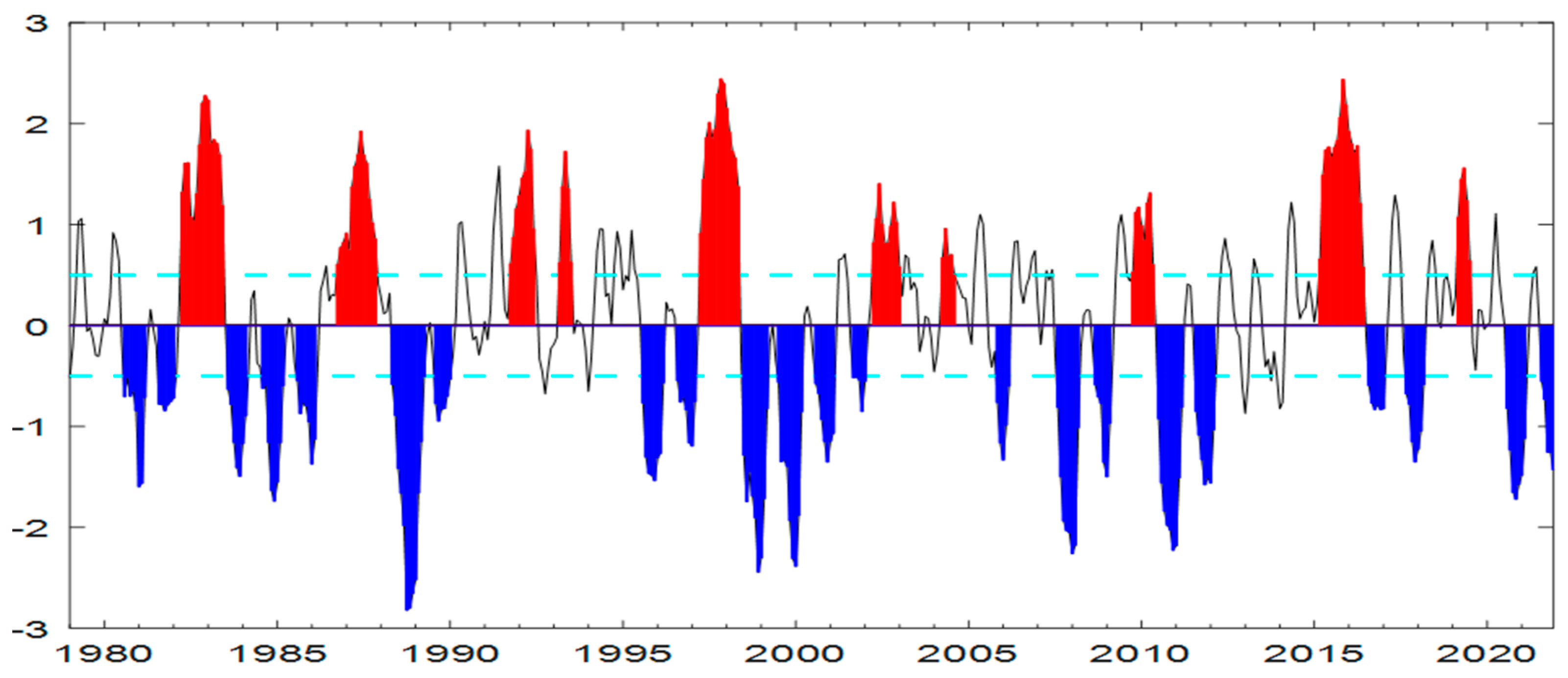

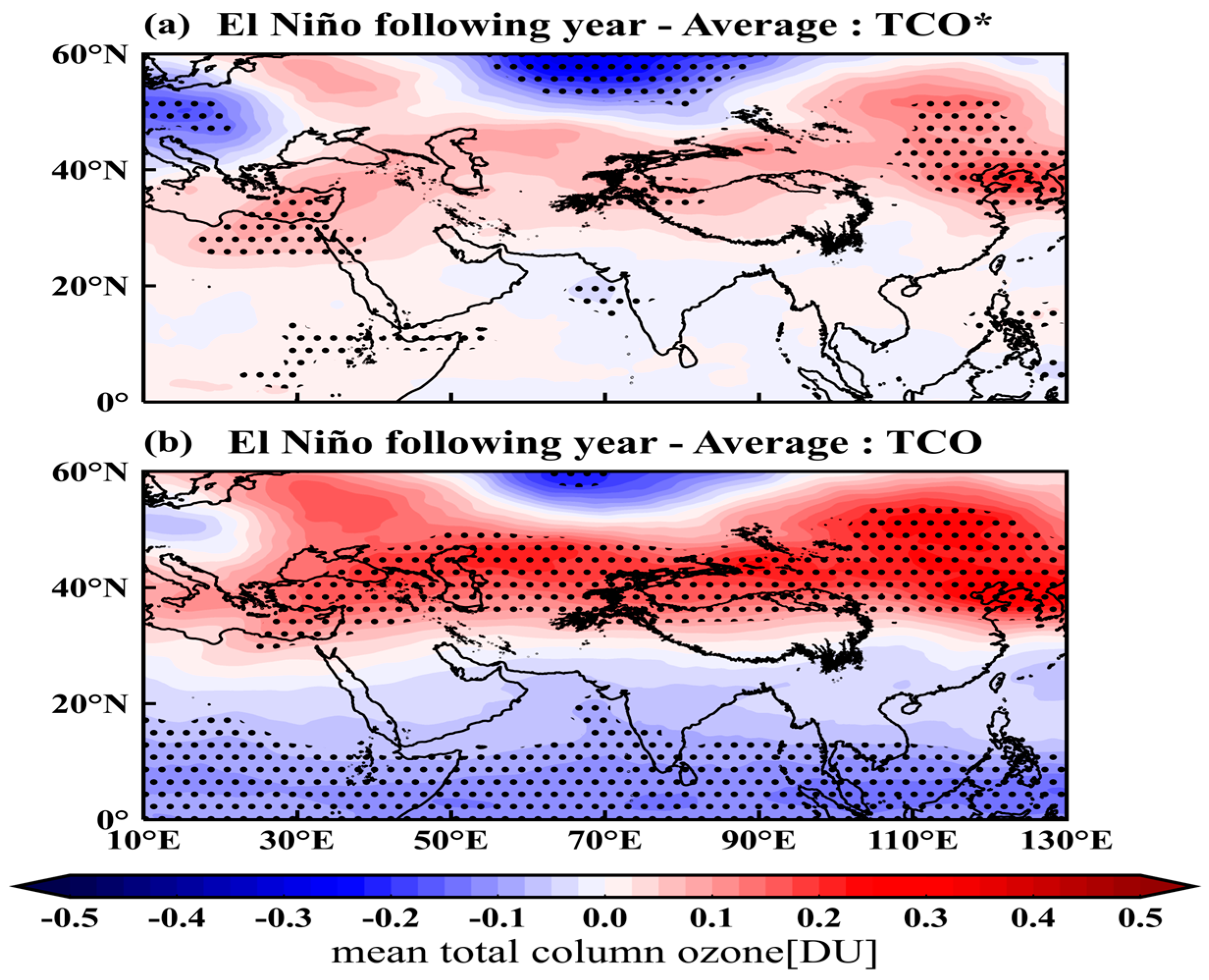
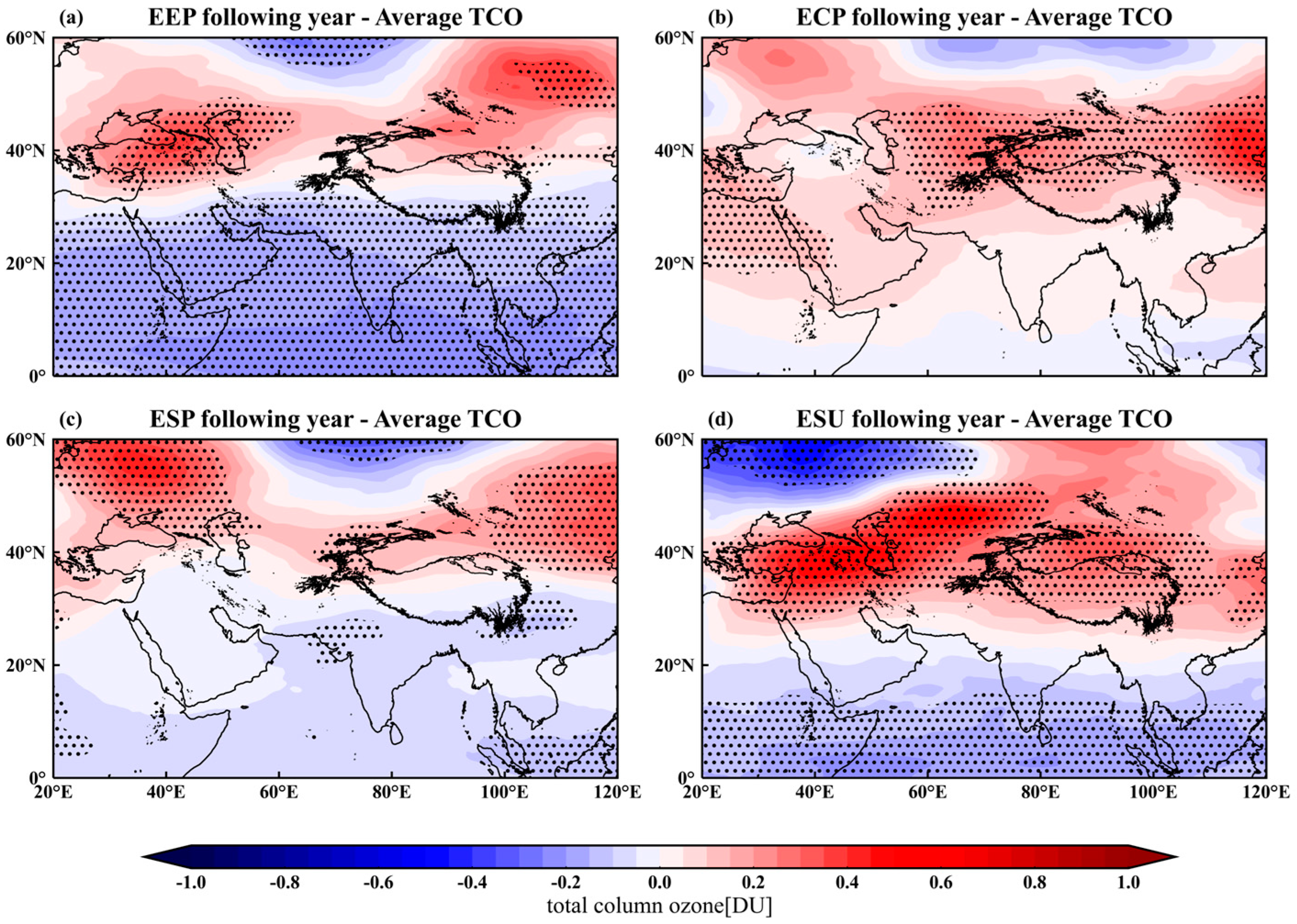
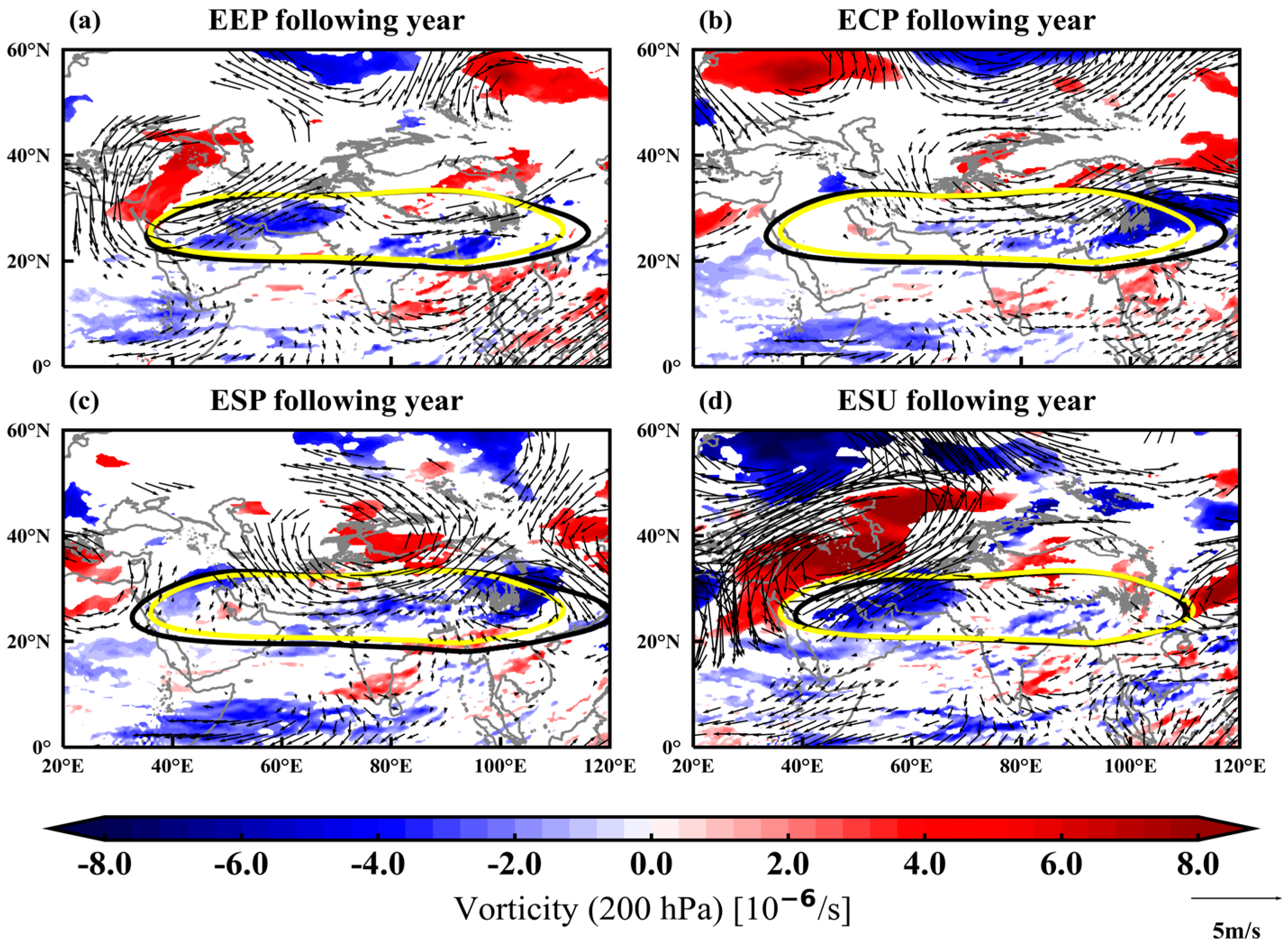
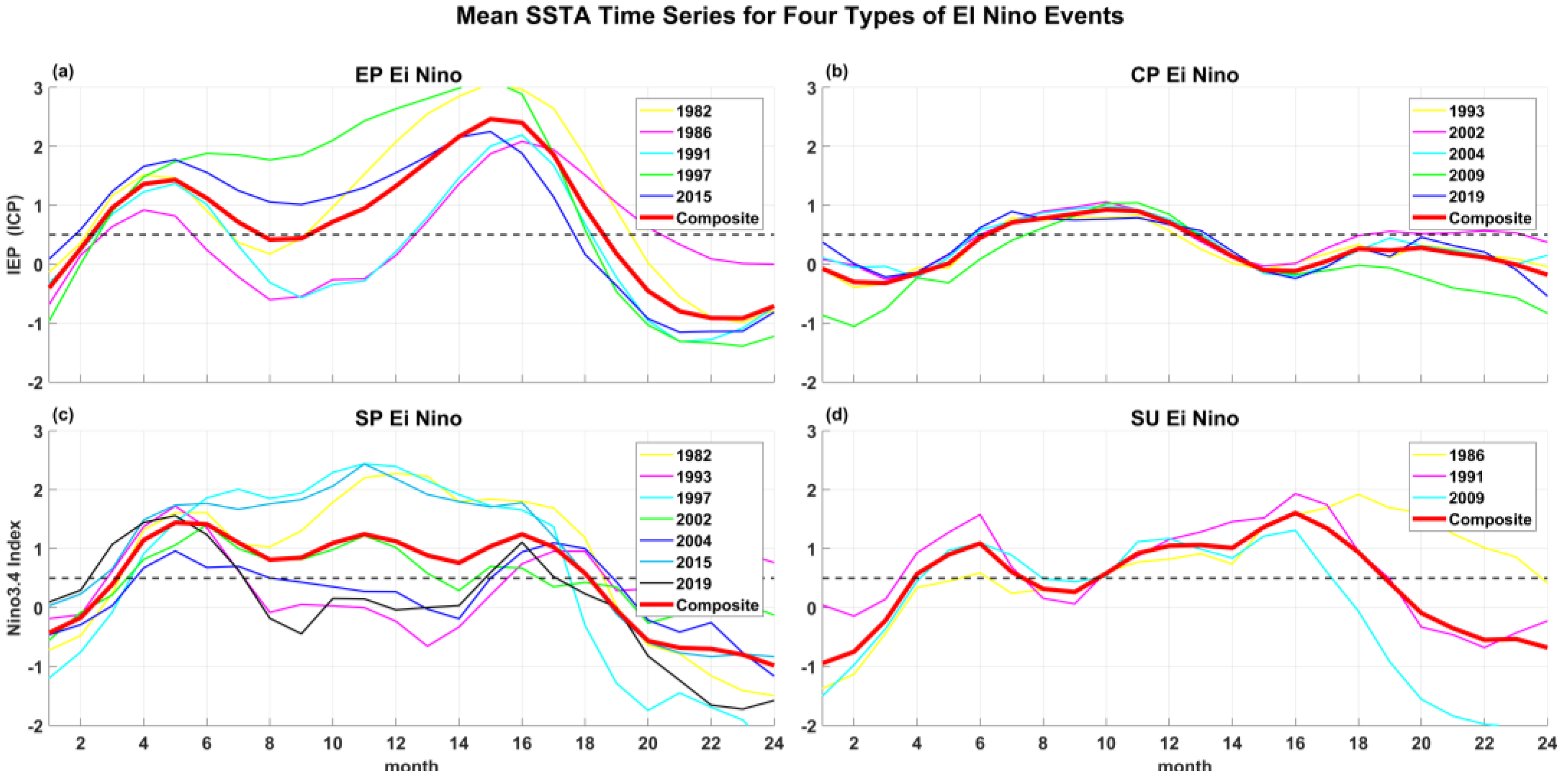

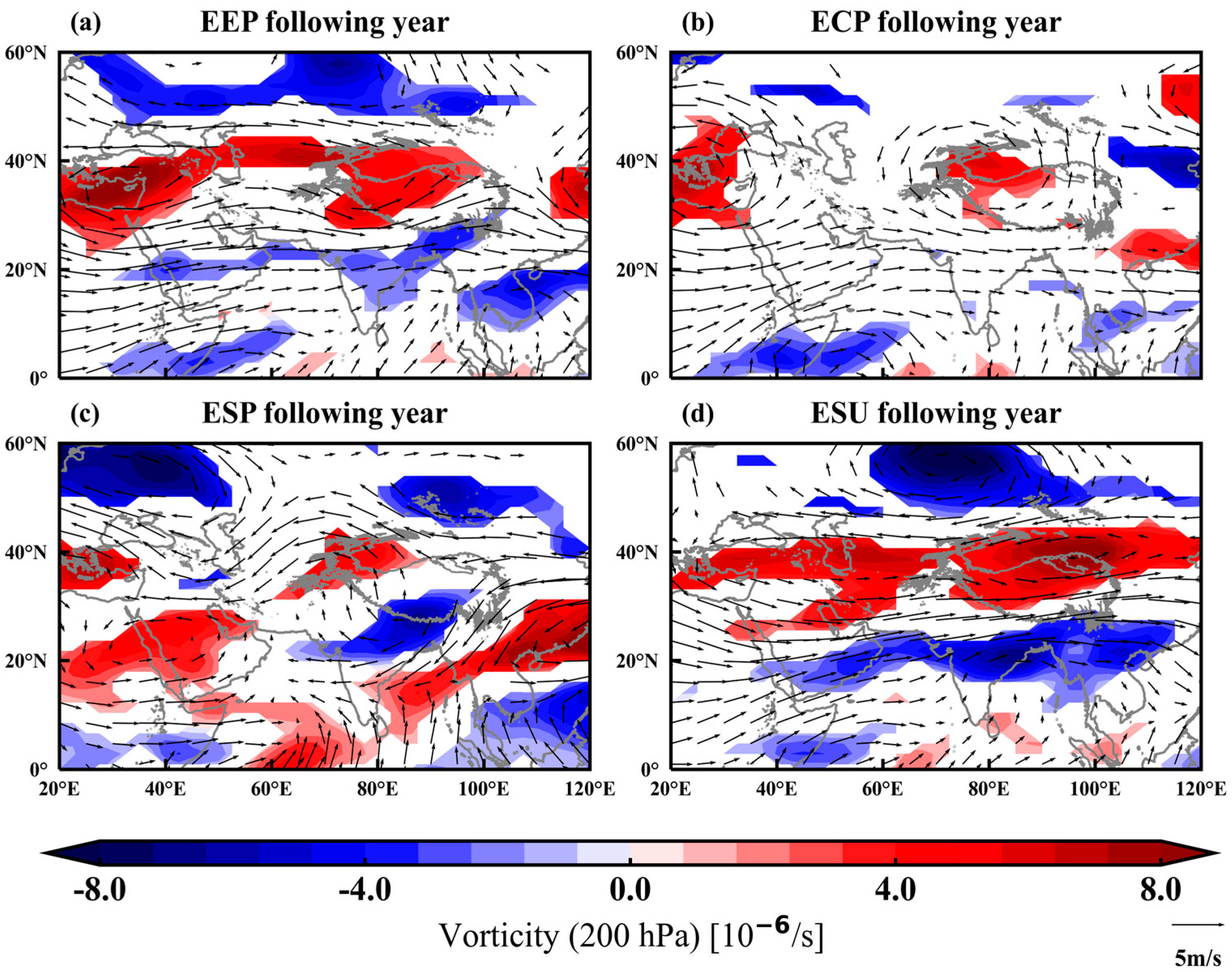
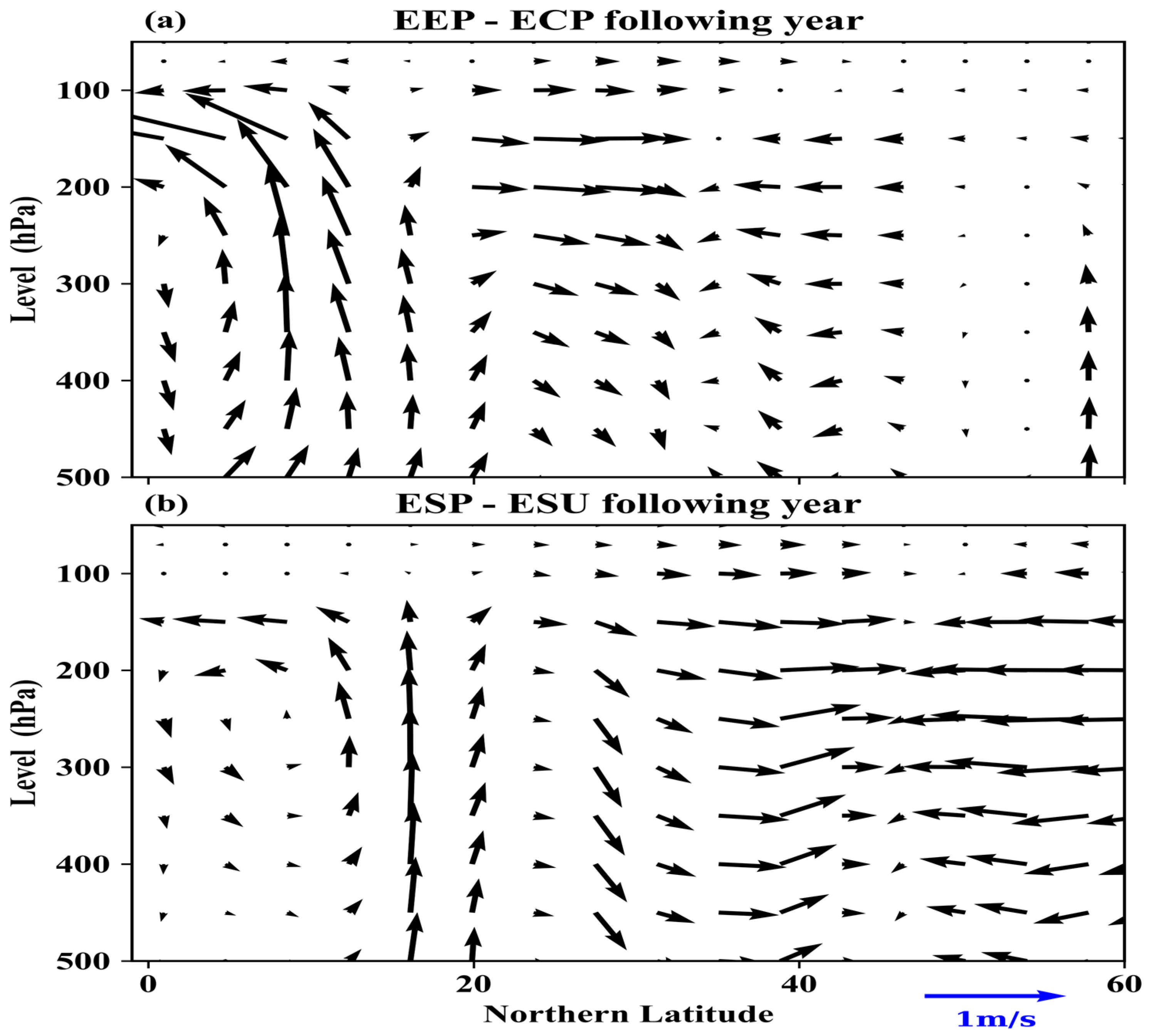
| Time | Beginning Month | Duration/Month | Spatial Type | Temporal Type | Peak SSTA/°C | Peak Time | Impact Years |
|---|---|---|---|---|---|---|---|
| 1982.03–1983.06 | 03 | 16 | EP | SP | 2.27 | 1982.12 | 1983 |
| 1986.10–1987.11 | 10 | 14 | EP | SU | 1.92 | 1987.06 | 1988 |
| 1991.10–1992.06 | 10 | 9 | EP | SU | 1.93 | 1992.04 | 1992 |
| 1993.03–1993.07 | 03 | 5 | CP | SP | 1.72 | 1993.05 | 1993 |
| 1997.04–1998.05 | 04 | 14 | EP | SP | 2.44 | 1997.11 | 1998 |
| 2002.04–2003.01 | 04 | 10 | CP | SP | 1.22 | 2002.11 | 2003 |
| 2004.04–2004.08 | 04 | 5 | CP | SP | 0.70 | 2004.07 | 2005 |
| 2009.10–2010.05 | 10 | 8 | CP | SU | 1.31 | 2010.04 | 2010 |
| 2015.03–2016.06 | 04 | 16 | EP | SP | 2.44 | 2015.11 | 2016 |
| 2019.03–2019.07 | 03 | 5 | CP | SP | 1.56 | 2019.05 | 2019 |
| Categories | The Year of the Ozone Valley in the Summer of the Following Year Affected by the Peak of EN Events |
|---|---|
| EP | 1983, 1988, 1992, 1998, 2016 |
| CP | 1993, 2003, 2005, 2010, 2019 |
| SP | 1983, 1992, 1998, 2003, 2005, 2016, 2019 |
| SU | 1988, 1992, 2010 |
| Trial | Added SST Category | Simulation Process |
|---|---|---|
| E0 | Actual SST | Controlled experiment. Simulation time: 1955–2005. The input SST is normal. |
| E1 | EP EN SST | Sensitive experiment. Simulation time: 1955–2005. The first five years are the start-up years of the experiment, and the normal SST series is added. Then, every five years, the SST forcing of EP EN events synthesized by observations is added in the first two years, and only the SST months with SSTA ≥ 0.5 °C are retained; the other months have a normal SST. The following three years were marked by normal annual SST forcing. The SST forcing range is 15° S–15° N, 135° E–80° W. |
| E2 | CP EN SST | Similar to E1, but with the addition of the composite SST observed by the CP EN events. |
| E3 | SP EN SST | Similar to E1, but with the addition of the composite SST observed by the SP EN events. |
| E4 | SU EN SST | Similar to E1, but with the addition of the composite SST observed by the SU EN events. |
Disclaimer/Publisher’s Note: The statements, opinions and data contained in all publications are solely those of the individual author(s) and contributor(s) and not of MDPI and/or the editor(s). MDPI and/or the editor(s) disclaim responsibility for any injury to people or property resulting from any ideas, methods, instructions or products referred to in the content. |
© 2024 by the authors. Licensee MDPI, Basel, Switzerland. This article is an open access article distributed under the terms and conditions of the Creative Commons Attribution (CC BY) license (https://creativecommons.org/licenses/by/4.0/).
Share and Cite
Wan, Y.; Xu, F.; Chang, S.; Wan, L.; Li, Y. The Impact of Different Types of El Niño Events on the Ozone Valley of the Tibetan Plateau Based on the WACCM4 Mode. Appl. Sci. 2024, 14, 1090. https://doi.org/10.3390/app14031090
Wan Y, Xu F, Chang S, Wan L, Li Y. The Impact of Different Types of El Niño Events on the Ozone Valley of the Tibetan Plateau Based on the WACCM4 Mode. Applied Sciences. 2024; 14(3):1090. https://doi.org/10.3390/app14031090
Chicago/Turabian StyleWan, Yishun, Feng Xu, Shujie Chang, Lingfeng Wan, and Yongchi Li. 2024. "The Impact of Different Types of El Niño Events on the Ozone Valley of the Tibetan Plateau Based on the WACCM4 Mode" Applied Sciences 14, no. 3: 1090. https://doi.org/10.3390/app14031090




